The beauty of spring bulbs isn’t just in the flowers that bloom. They’re also about the easiest kind of garden you can grow. Dig a hole, sprinkle in some fertilizer, put them in the ground now (and up until early December in warm Southern climates), add water, and pretty much forget about them.
The best time to plant spring-blooming bulbs is in the fall, typically between September and November, depending on your climate. This timing allows the bulbs to establish roots before the ground freezes. Zones 4-7 should plant them in the early fall, while zones 8-9 should wait for mid-fall. Zones 10-11 should wait until late fall for the best results.
They’ll start establishing roots in autumn’s cool, moist soil, then lie dormant over the winter until spring’s warmer temperatures and frequent rains prompt them to sprout. If you miss the fall, it’s best to wait until the following year to plant bulbs.
What To Know About Planting Spring Bulbs
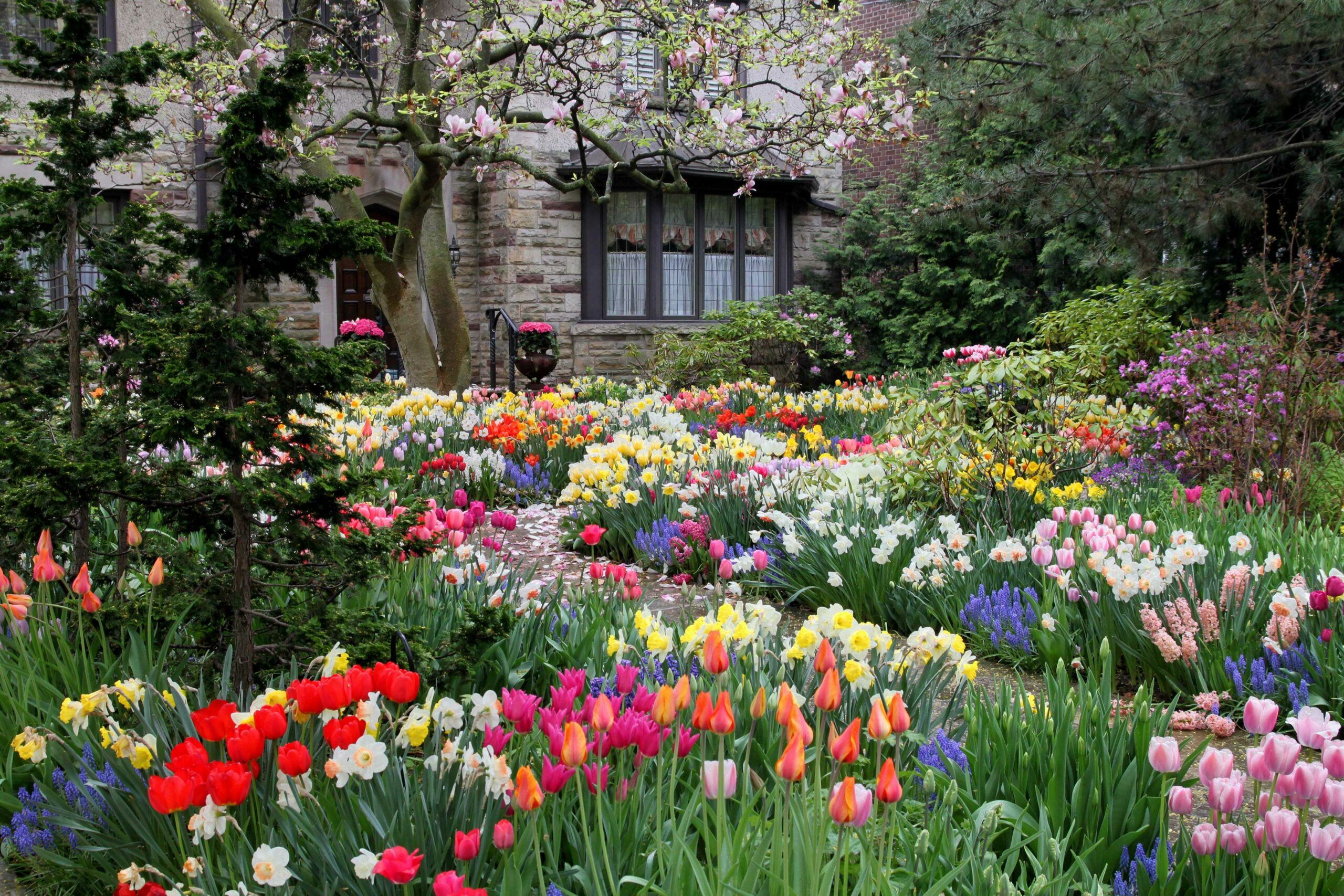
Before getting started, you’ll need to know how to choose the right bulbs. When selecting bulbs, look for ones that are:
- Stored in a cool, dry place until planting
- Firm to the touch
- Free of mold or soft spots
- Heavy for their size
How To Add Bulbs to Your Yard
There are a number of ways to work bulb plants into your yard:
- Cluster up to half a dozen of them in a large hole to add a colorful punch amid flower beds and shrub borders; plant them in rows where space is tight
- Encircle the base of a tree for a flower-filled focal point
- If your yard borders woodland, scatter them and plant them where they fall for naturalistic drifts of color.
Consider the look you want for the bulbs. For a structured, varied look, read the labels carefully and organize the bulbs by bloom time, height, and color. This ensures a variety of color and flowers all throughout the spring.
For a more natural, wild look, try throwing the bulbs in the area you want to plant them. Wherever they land, plant them there.
If you’re going to row- or scatter-plant, here’s a tip: “I always plant doubles,” says This Old House landscape contractor Roger Cook. “That way, you get more foliage and flowers for your digging efforts.”
Choose varieties that bloom at different times during the season, and you can extend your spring-flowering garden for several weeks.
When you’re ready to break ground, grab a trowel (or a spade shovel where soil is very compacted), a 10-10-10 fertilizer, and some bags of bulbs, then follow these steps.
Considering Height and Bloom Time
When planning your garden, keep in mind the following:
- Plant taller varieties behind shorter ones
- Stagger bloom times for extended seasonal interest
- Mix early, mid, and late-spring bloomers for a dynamic display
Choosing the Right Soil for Spring Bulbs
Spring-blooming bulbs thrive in well-draining soil. Bulbs planted in heavy or clay soil can suffer from rot during wet winter months. For the best results, check your soil’s pH balance before planting and amend it as needed.
- Drainage: Ensure that the ground has good drainage.
- Soil Type: Sandy or loamy soil is optimal.
- Soil pH: Most bulbs prefer a neutral pH. Adjust the soil to measure between 6. 0 and 7. 0.
After preparing your soil, refrain from adding too much organic material, which can hold excess water and harm bulbs.
Enhancing Your Soil for Bulbs
Improving your soil can play a crucial role in the success of your spring-blooming bulbs.
- Compost: Add a moderate amount of compost to enhance soil fertility.
- Sand: Mix in sand to improve drainage if your soil tends to retain water.
- Bulb Fertilizer: Consider adding a slow-release, balanced bulb fertilizer to nourish your bulbs.
How To Plant Spring Bulbs
Step 1: Prepare the hole
To plant a cluster of three to five daffodil bulbs, loosen the soil with a trowel and dig a hole about 7 inches deep and 6 to 8 inches wide. (For tulips, dig down about 5 inches, and for tiny crocus bulbs, about 2 inches.)
How deep to dig? Follow this formula: Height of bulb in inches x 2.5= depth of hole
Step 2: Sprinkle in fertilizer
To stimulate root growth, scratch a scant handful of granular fertilizer into the soil at the bottom of the hole, and flatten the area with your hand so bulbs have a stable surface to rest on.
Step 3: Place bulbs
Put bulbs in the prepared hole about an inch apart, with tip up and root end down. Then cover with soil, and water once to settle them.
Sandwich Bulbs for Six Weeks of Spring Blooms
Want to brighten up a deck or patio? Grab a container and plant layers of bulbs that will give you three bursts of color when spring arrives. Choose bulb varieties that flower a few weeks apart, such as crocus, tulips, and daffodils, which will bloom in rotation for up to six weeks. To fill a container that’s 12 inches in diameter and 12 to 14 inches deep, you’ll want about nine crocus, seven tulip, and five daffodil bulbs.
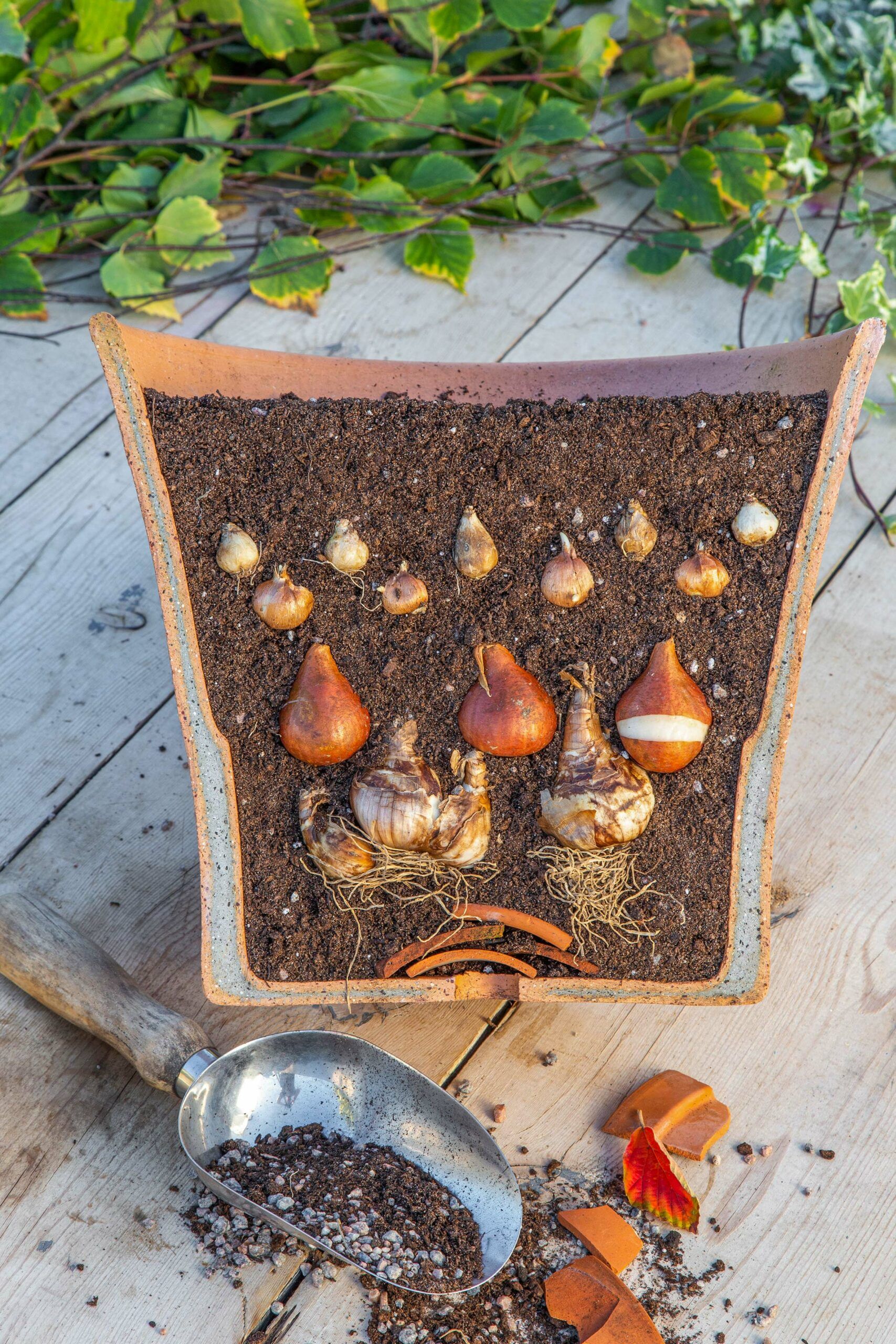
- First, add a one-inch layer of pebbles to the bottom of the container (make sure there’s a drainage hole or drill one out).
- Add four inches of potting soil, and mix in a tablespoon of 10-10-10 fertilizer.
- Place the daffodil bulbs with their flat, root end down and pointed end up, making sure the sides aren’t touching.
- Add another one-inch layer of potting soil, covering the bulbs to their tips.
- Place the row of tulip bulbs so they’re staggered over the daffodils and not directly on top.
- Cover with soil; repeat steps with crocus bulbs.
- Cover the “sandwiched” bulbs with one to two inches of mulch, and water thoroughly. Keep soil moist throughout the fall, then let the container winter over (in an unheated garage or shed in climates with very cold winters) until warm spring rains encourage the first shoots to appear.
Types of Bulbs to Plant for Spring
Crocus, daffodils, and hyacinth are favorites for spring color, with dozens of varieties that will come back year after year (if you don’t cut back the fading foliage they feed on after they’ve bloomed.) These naturalizing bulbs will even multiply and spread as time goes by.
Tulips are another classic, but they don’t rebloom as reliably. “I treat tulips like annuals and replenish them each year,” says Cook. They’re also a favorite of foraging wildlife. “Deer, rabbits, and squirrels treat tulip bulbs like caviar. If you’ve got a critter problem, stick to daffodils.”
You also may want to base your bulb type on what zone you live in. Zones 3-5 should choose bulbs that tolerate colder weather and longer winters, such as crocuses, daffodils, or snowdrops.
Zones 6-8 will have a wider variety to choose from, including tulips, hyacinths, and anemones. Zones 9-11, meanwhile, need to opt for bulbs that can withstand warmer temperatures, such as freesias, ranunculus, and watsonias.
Dutch Crocus
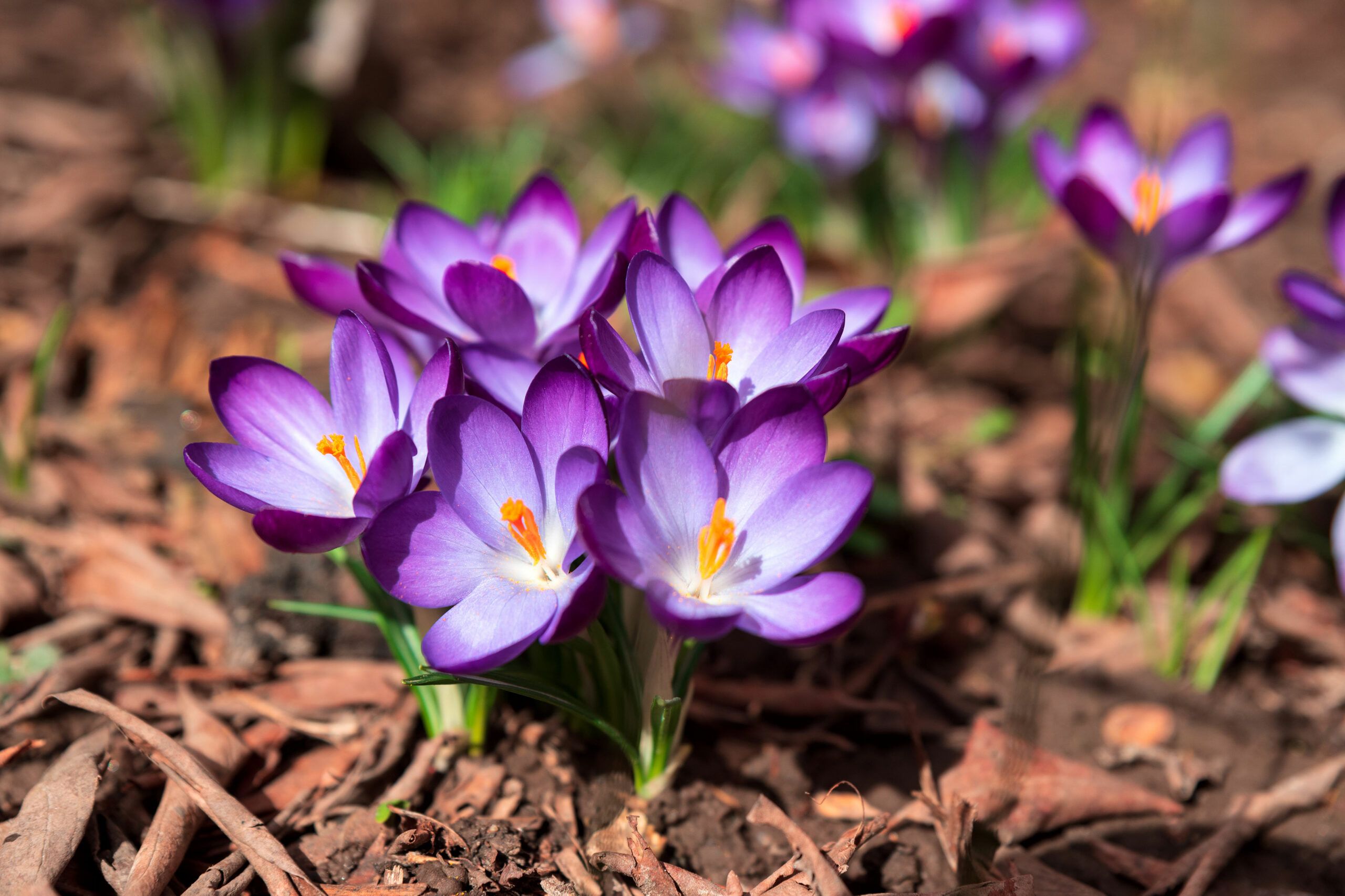
(Crocus vernus species) This early-spring bloomer flowers in shades of lavender and purple; grows up to four inches tall.
Red Emperor Tulip
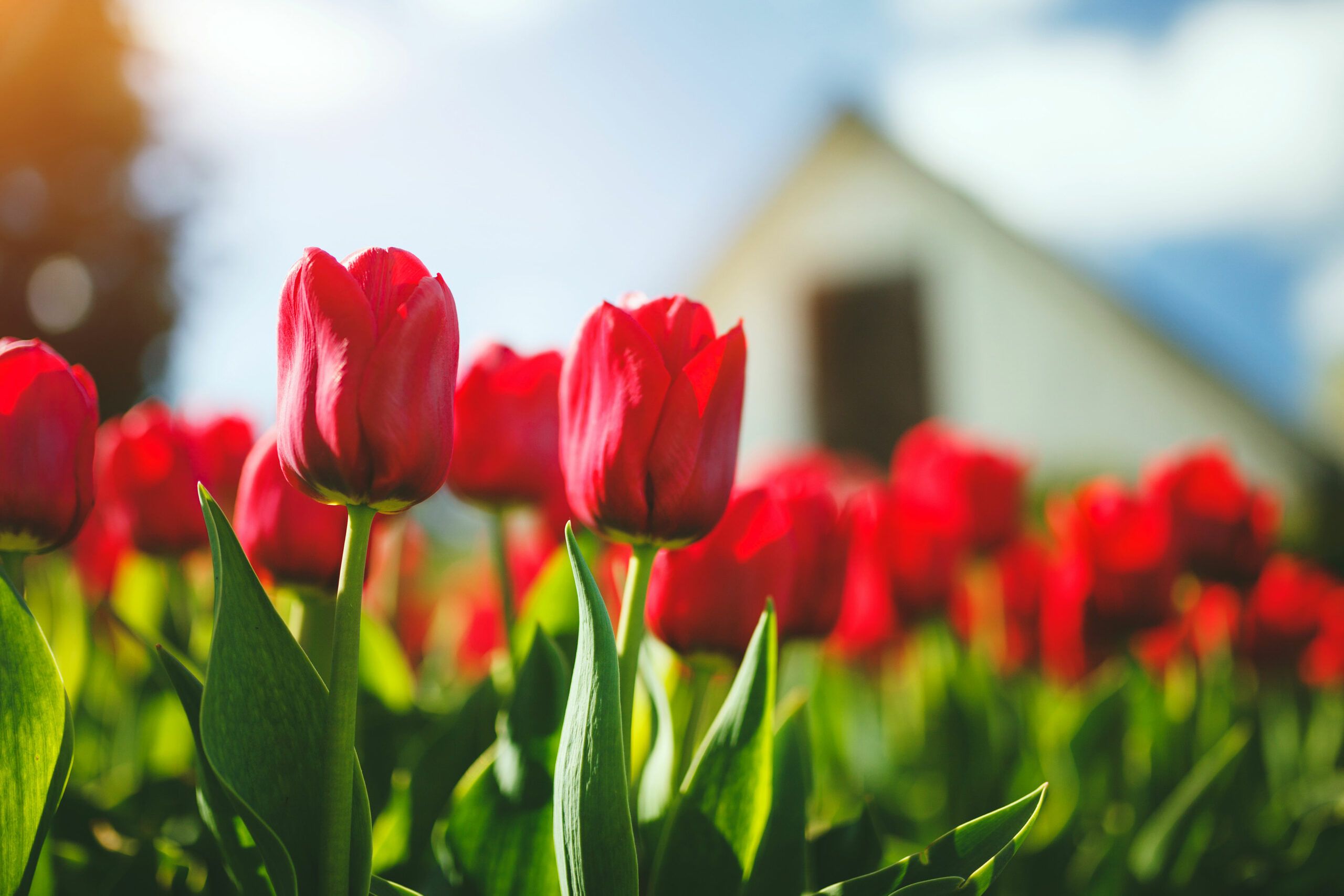
(Tulipa ‘Red Emperor’) A mid-season bloomer with a large, dramatic red flower with a black “eye”; grows up to 20 inches tall.
King Alfred Daffodil
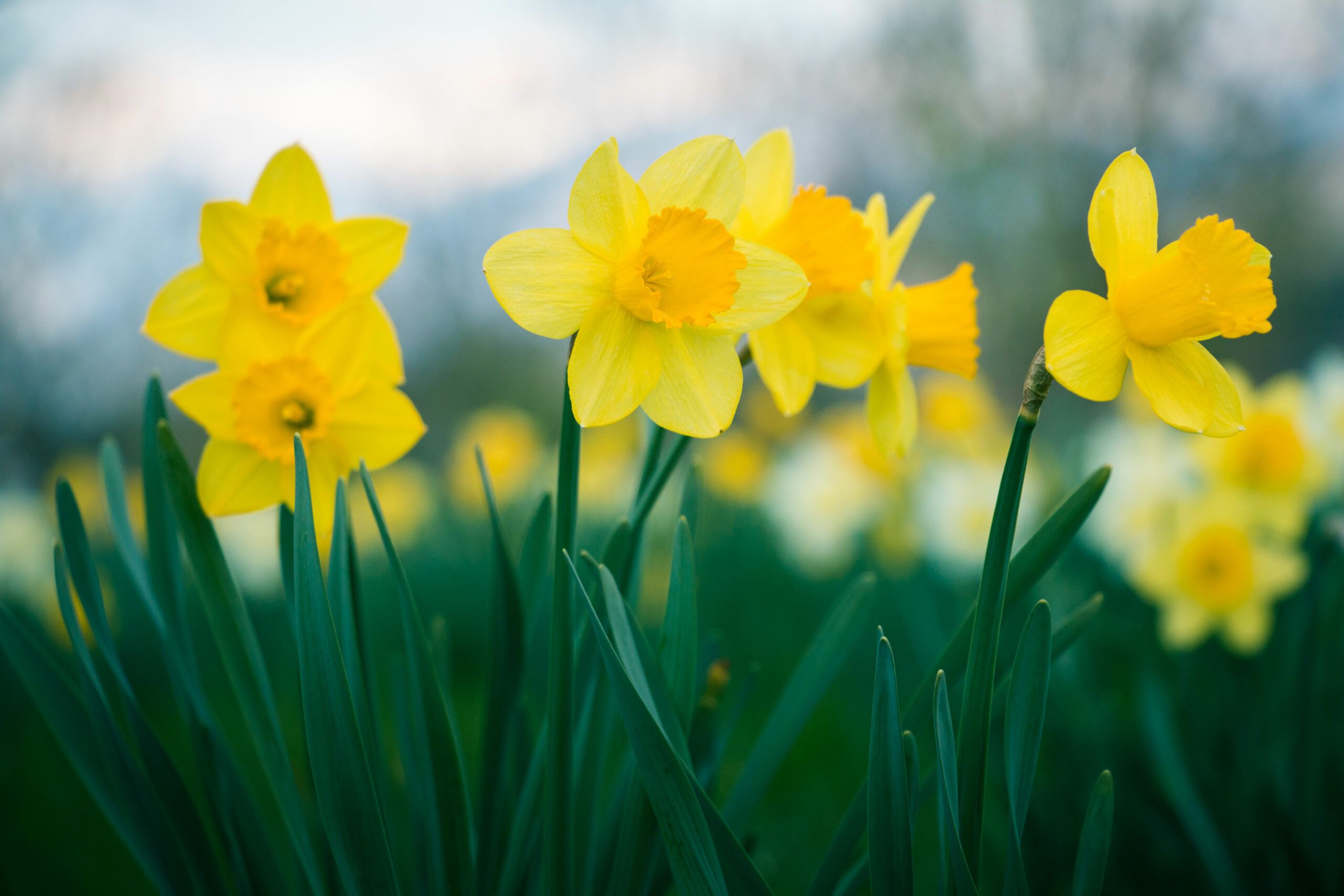
(Narcissus dahlia ‘King Alfred’) A late-spring bloomer with a large trumpet; grows up to 20 inches tall.
Creating Bulb Combinations
Combining different types of bulbs in one area can elevate the beauty and diversity of your garden.
- Color Harmony: Combine colors that complement each other, such as violet crocuses with yellow daffodils.
- Sequential Blooming: Mix early, mid, and late bloomers to ensure continuous flowering throughout spring.
- Varied Heights: Plant shorter bulbs in front and taller ones behind for a tiered effect.
Caring for Spring-Blooming Bulbs
Proper care ensures your bulbs will return year after year, creating a lasting spring display.
Watering and Fertilizing
- Water bulbs thoroughly after planting and during dry spells in fall and spring.
- Apply a balanced fertilizer in early spring when shoots first emerge.
- Avoid overwatering, as this can lead to bulb rot.
Seasonal Care Tips
Adapting your care routine to the seasonal needs of your spring-blooming bulbs can make a big difference. In the fall, ensure good watering until the first freeze. In the winter, mulch over the planting area to protect bulbs from extreme cold. In the spring, fertilize early as the shoots appear and maintain consistent watering.
Post-Bloom Care
After your bulbs have finished blooming:
- Allow foliage to die back naturally, as this replenishes the bulb’s energy for next year’s bloom.
- Cut off spent flower stalks to prevent seed formation.
- Consider lifting and dividing overcrowded bulbs every three to four years.
Protecting Bulbs from Wildlife
Some spring-blooming bulbs, particularly tulips, are attractive to wildlife. To protect your garden:
- Plant daffodils, which are naturally deer and rodent-resistant.
- Use physical barriers like chicken wire or hardware cloth around plantings.
- Apply animal repellents according to package instructions.
Natural Repellents
For a more eco-friendly approach, consider natural repellents to deter wildlife, such as:
- Garlic Spray: An effective and safe option.
- Blood Meal: A natural fertilizer that deters animals.
- Pepper Spray: Easy to make at home and non-toxic.
